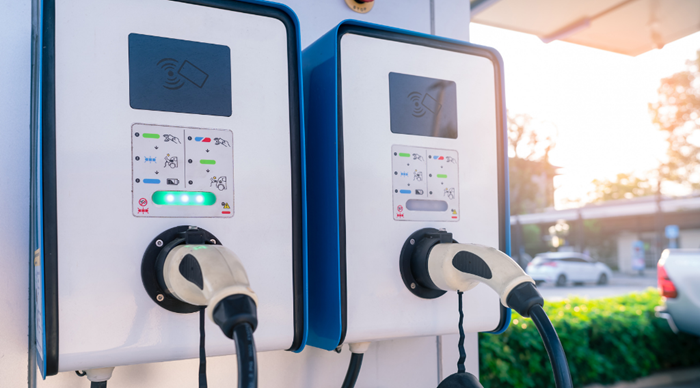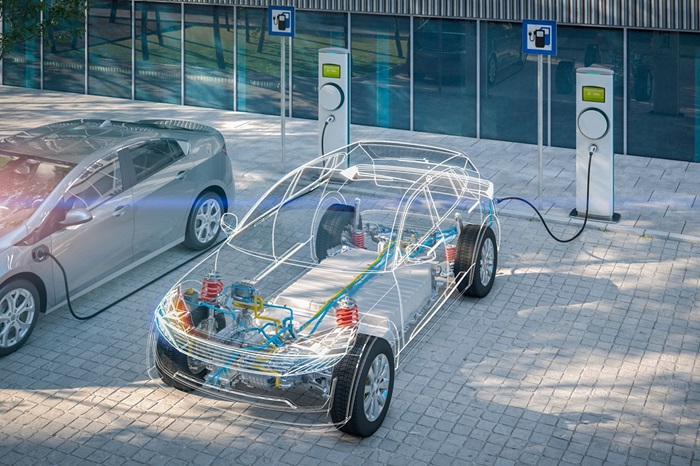Level 1 EV Charger Speed: Slow and Steady
Level 1 chargers offer a convenient and affordable way to charge an EV, but their slow speed makes them impractical for daily use. They are best suited for occasional top-ups or overnight charging for drivers with limited driving needs.
As EV technology continues to evolve, faster charging options are likely to become the preferred choice for most drivers.

Discover the Speed of Level 1 EV Chargers
Level 1 chargers operate on a 120-volt circuit, delivering a charging speed between 1.3 kW and 2.4 kW. This translates to adding roughly 3-5 miles of range to your EV’s battery per hour of charging.
There is no best speed for Level 1 chargers, because:
- Limited by Outlet Capacity: The 120-volt household outlet restricts the maximum power output a Level 1 charger can deliver.
- Focus on Overnight Charging: Level 1 is ideal for scenarios where you have ample charging time, like overnight top-ups for daily commutes. Since charging happens over extended periods, a single “best” speed isn’t as crucial.

Optimizing Level 1 Charging:
While the speed itself isn’t adjustable, you can optimize Level 1 charging for efficiency:
- Off-Peak Charging: Many electricity providers offer lower rates during off-peak hours. Plugging in during these times can save money while maximizing the charging window.
- Proper Connections: Ensure a secure and snug connection between the charger and the outlet for efficient power transfer.
Remember, Level 1 is best for overnight charging or topping up when time isn’t a pressing concern. If you need faster charging options, consider:
- Level 2 Charger Installation: Offers significantly faster charging times (25-75 miles per hour) through a 240-volt circuit.
- Public Charging Stations: Utilize Level 2 or DC Fast Charging options for even quicker charging on the go.
Detailed Understanding of Level 1 Charging Speed
Level 1 charging is the slowest method of charging an electric vehicle (EV), typically utilizing a standard household outlet (120 volts in the US and Canada, 230 volts in Europe). Understanding the factors affecting Level 1 charging speed requires consideration of various elements:

- Charging Rate: Level 1 chargers provide relatively low power output compared to Level 2 chargers and DC fast chargers. They typically offer a charging rate of 2 to 5 miles of range per hour (or roughly 4 to 8 kilometers per hour), depending on the EV model and its efficiency.
- Power Output: The power output of a Level 1 charger is limited by the standard household outlet it’s connected to, which typically ranges from 1.2 kW to 1.9 kW. This limits the charging speed compared to Level 2 chargers, which can deliver higher power outputs ranging from 3.3 kW to 19.2 kW or more.
- Battery Capacity: The battery capacity of an EV, measured in kilowatt-hours (kWh), also influences the charging time. Larger battery capacities require more energy to charge fully, resulting in longer charging times.
- Charging Efficiency: The efficiency of the charging process can vary depending on factors such as the EV’s battery management system, charging equipment efficiency, and battery temperature. Some energy may be lost as heat during charging, especially with Level 1 charging due to its slower speed.
- Environmental Conditions: Environmental factors such as temperature can impact charging speed. Extreme temperatures, both hot and cold, can reduce battery efficiency and slow down the charging process. High temperatures may necessitate additional cooling measures to maintain optimal charging conditions, while low temperatures can increase charging times due to reduced battery performance.
- Battery State of Charge: Charging speed typically decreases as the battery approaches full capacity. This phenomenon, known as tapering, occurs to protect the battery from overcharging and reduce heat generation. As a result, the charging rate may slow down significantly when the battery is near full capacity.
- Voltage Drop: A voltage drop along the electrical wiring can affect charging speed, especially for longer distances or older wiring. Lower voltage at the charger can result in reduced power output and slower charging rates.
Understanding these factors helps EV owners anticipate charging times and optimize their charging strategies. While Level 1 charging may be suitable for overnight charging or low-demand scenarios, EV owners may consider Level 2 chargers or DC fast chargers for faster charging when needed, especially for longer trips or higher-capacity batteries.
Comparing Level 1 Charging Speeds
Level 1 vs. Other Charging Levels
Here’s a quick comparison of Level 1 with other charging levels:
| Charger Level | Power Output | Charging Speed | Typical Use Case |
| Level 1 | 1.3-2.4 kW | 3-5 miles/hour | Overnight charging for daily commutes |
| Level 2 | 6.2-19.2 kW | 25-75 miles/hour | Home charging, public charging stations |
| Level 3 (DC Fast Charging) | 50 kW – 350+ kW | Up to 200+ miles in 30 minutes | Long-distance travel, public charging stations |
As you can see, Level 2 and DC Fast Charging offer significantly faster charging times.

Charging Time with Level 1
The charging time for your EV with a Level 1 charger depends on your battery capacity. Here’s a general idea:
- Small Battery (around 24 kWh): 5-8 hours for a full charge
- Medium Battery (around 40 kWh): 8–13 hours for a full charge
- Large Battery (around 60 kWh or more): 12–20+ hours for a full charge
Calculating Charging Time:
To precisely calculate your charging time, you can use this formula:
Charging Time (hours) = Battery Capacity (kWh) / Charging Power (kW) / Charging Efficiency
Adjusting for Efficiency and Power Output:
- Charging Efficiency: Factor in a charging efficiency of around 85–90% when calculating real-world charging time.
- Power Output Variation: The actual power output of a Level 1 charger can vary depending on your circuit and local regulations.
Level 1 charging is slow but sufficient for overnight charging when you have access to a nearby outlet. For faster charging options, consider Level 2 or DC Fast Charging stations.
How Can I Optimize the Charging Speed of My Level 1 EV Charger?
Optimizing the charging speed of your Level 1 EV charger primarily involves maximizing efficiency and leveraging available technologies. Here are some tips to enhance charging speed with a Level 1 charger:

- Utilize Off-Peak Charging Hours:
Many utility providers offer lower electricity rates during off-peak hours, typically late at night or early in the morning. Charging your EV during these times can not only save you money but also reduce strain on the electrical grid. Some EV charging stations and vehicles have scheduling features that allow you to automatically charge during off-peak hours.
- Maintain Proper Electric Connections:
Ensure that your electrical connections are in good condition to facilitate efficient charging. This includes using a dedicated circuit for your EV charger, avoiding the use of extension cords (unless specifically designed for EV charging), and ensuring that the outlet and wiring are rated to handle the charging load.
- Upgrade the Power Supply:
If feasible, consider upgrading your electrical service to support faster charging. Installing a higher amperage circuit or upgrading to a Level 2 charger can significantly reduce charging times compared to Level 1 charging. However, this may require professional installation and potentially additional costs.
- Utilize Smart Charging Technology:
Smart charging solutions enable you to optimize charging based on factors such as electricity rates, grid demand, and your EV’s schedule. Smart chargers can automatically adjust charging power to minimize costs and maximize efficiency. Additionally, some EVs have built-in smart charging capabilities that allow you to remotely monitor and control charging settings through a mobile app.
- Maximize Efficiency:
To maximize charging efficiency, ensure that your EV’s battery management system is functioning optimally. Keep your battery within its recommended temperature range, as extreme temperatures can affect charging efficiency and battery longevity.
Additionally, consider pre-conditioning your EV’s cabin temperature while it’s still connected to the charger, as this can reduce the need for energy-intensive heating or cooling while driving.
By implementing these strategies, you can optimize the charging speed of your Level 1 EV charger, making the most efficient use of your charging time and minimizing the impact on your electricity bill.
Limitations and Upgrading Options
There are limitations to the speed of Level 1 EV chargers, primarily due to their lower power output compared to Level 2 chargers. Level 1 chargers typically operate on standard household electrical outlets (120 volts in the US and Canada, 230 volts in Europe) and provide relatively slow charging speeds, typically ranging from 2 to 5 miles of range per hour of charging.
This charging rate may not be sufficient for some EV owners, especially those with higher-capacity batteries or longer daily driving distances.

Upgrading to a Level 2 charger can indeed be a better option for faster charging. Level 2 chargers require a dedicated 240-volt electrical circuit and are capable of delivering higher power outputs, typically ranging from 16 to 80 amps.
As a result, Level 2 chargers can provide significantly faster charging speeds compared to Level 1 chargers, often delivering around 10 to 60 miles of range per hour of charging, depending on the charger’s power output and the EV’s capability.
The benefits of Level 2 chargers in terms of speed include:
- Faster Charging: Level 2 chargers can replenish an EV’s battery much more quickly than Level 1 chargers, reducing overall charging times and providing greater convenience for EV owners, especially those with longer daily commutes or frequent long-distance travel.
- Compatibility with High-Capacity Batteries: Level 2 chargers are better suited for EVs with larger battery capacities, as they can provide the higher charging power needed to efficiently charge these vehicles within a reasonable amount of time.
- Flexibility and Convenience: Level 2 chargers are often equipped with features such as smartphone connectivity, scheduling capabilities, and charging station locator services, enhancing the overall user experience and making it easier for EV owners to manage their charging needs.
However, it’s essential to consider the cost implications of upgrading to a Level 2 charger. While Level 2 chargers offer faster charging speeds and added convenience, they typically require professional installation and may involve higher upfront costs compared to Level 1 chargers.
Additionally, installation costs may vary depending on factors such as electrical wiring upgrades, permit requirements, and labor charges.
EV owners should weigh the benefits of faster charging against the upfront and ongoing costs associated with upgrading to a Level 2 charger to determine the most suitable charging solution for their needs.
Future Developments in Level 1 Charging Technology
While Level 1 EV chargers are inherently limited by the standard household electrical outlets they rely on, there are some potential developments that could improve their charging speed and efficiency in the future:

- Advancements in Charging Infrastructure:
Future developments in electrical infrastructure could potentially increase the power output available from standard household outlets, thus allowing for faster Level 1 charging without requiring significant changes to existing wiring or outlets.
For example, advancements in electrical grid technology, smart meters, and energy management systems could enable more efficient allocation of electricity resources, potentially optimizing charging speeds for Level 1 chargers.
- Integration of Rapid Charging Capabilities:
Although Level 1 chargers are typically associated with slower charging speeds compared to Level 2 and DC fast chargers, there could be advancements in technology that allow for the integration of rapid charging capabilities into Level 1 chargers.
For instance, future Level 1 chargers could incorporate features such as higher charging currents, improved power electronics, and enhanced thermal management systems to deliver faster charging speeds while still utilizing standard household outlets.
- Smart Charging and Communication:
Integration of smart charging capabilities into Level 1 chargers could enable communication between the charger, the EV, and the grid.
This could allow for more efficient charging strategies, such as load balancing to minimize grid impact, dynamic adjustment of charging rates based on electricity prices or grid demand, and optimization of charging schedules based on user preferences and energy availability.
- Battery and Charging Technology:
Advances in battery technology, such as higher energy densities and faster charging capabilities, could also indirectly impact Level 1 charging speeds by allowing EVs to charge more quickly even with lower power chargers.
Similarly, improvements in charging technology, such as more efficient power conversion and management systems, could enhance the overall efficiency and speed of Level 1 charging.
Overall, while Level 1 charging may remain relatively slow compared to other charging options, future developments in technology and infrastructure could still lead to improvements in charging speed and efficiency, making Level 1 charging more convenient and practical for a broader range of EV owners.
The potential for Level 1 EV chargers lies in their widespread accessibility through standard household outlets. However, their charging speeds are relatively slow, providing only 2 to 5 miles of range per hour.
Despite this limitation, future developments in charging infrastructure, the integration of rapid charging capabilities, advancements in smart charging technology, and improvements in battery and charging technology could enhance the speed and efficiency of Level 1 charging.
These developments may expand the practicality and convenience of Level 1 charging for a broader range of electric vehicle owners, offering a viable charging solution for overnight or low-demand scenarios.

Henry Michael is a leading expert in EV charging station research, specializing in innovative solutions for electric vehicle infrastructure. With a passion for sustainability and technological advancement, he is dedicated to advancing the accessibility and efficiency of EV charging worldwide.






